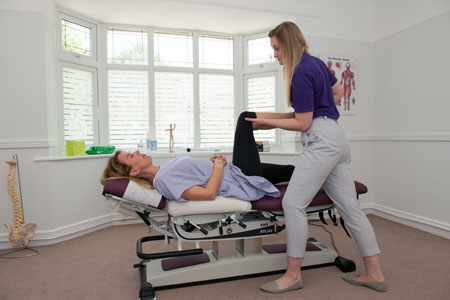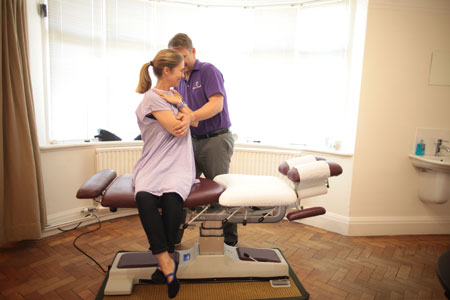
Hip / Groin / Thigh

Are you suffering from any of the following symptoms which are often linked to neck pain?
- Pain or ache in the hip, groin or thigh area
- Weakness or heaviness in the area
- Numbness/pins and needles
- Joint restriction
Hip, groin and thigh pain can be difficult to diagnose; it is essential that you get a thorough assessment by an experienced and qualified clinician to ensure the correct treatment plan.
The pelvis transmits the weight of the torso, arms, head, neck and spine down through the hips into the legs. Consequently, it carries a lot of weight and is prone to stress, as well as, daily wear and tear. It comprises the pubic bone at the front, the hip joints in the groin and the sacro-iliac joints (between the tailbone and pelvis) at the base of the spine.
The pubic bone is not in fact a bone, rather a joint between the left and right side of the pelvic bone where they meet at the front.
The hip joint is very deep and has strong ligaments tightly wound around it, keeping the hip extremely stable. It is less mobile than the shoulder so is less prone to strain or dislocation. However, the hip joint is one of the most common joints to suffer from osteoarthritis. As a heavy weight bearing area, the joint is commonly affected by arthritic changes. Pain from the hip joint is felt predominantly at the groin, though it can radiate down the front of the thigh and to the knee. Pain at the buttock or side of the hip is rarely from the hip joint, more commonly due to a bursitis, tendon or muscular problems. Pain in the hip can also cause weakness leading to limping and perpetuating the problem. It’s therefore important to have a thorough assessment both to ensure correct treatment and address any problems that may have occurred secondarily to the pain and cause it to recur if not addressed.
Conditions most commonly & successfully treated

- Osteoarthritis - the most common cause for surgical hip replacement. OA is caused by a stiffening of the joint combined with a loss of the cartilage between the 2 surfaces of the joint. ‘Wear and tear’ is somewhat of a misnomer, since it is usually inactivity that leads to joint stiffness. The hip is particularly prone to osteoarthritic change being such a heavily weight bearing joint. Symptoms include groin and hip pain, and possibly front of thigh, knee or buttock pain too. This is accompanied by a gradual restriction of the joint, especially into rotation. Treatment is essential to control symptoms and strengthen the area, controlling and monitoring progression. Activity can help to keep hip joints flexible and reduce inflammation
- Sprain/strain - too much stress through the joint can tear muscles and ligaments causing local pain. The groin, hamstring and quadriceps are the most commonly affected areas. Muscle strains occur when a muscle is taken past its comfortable anatomical limit and into damage. There are several factors that can affect this, including the speed at which the muscle was taken into strain, how fatigued it was at the time. Muscle strains are graded depending on how much the muscle has been torn and the grade of tear also determines how the muscle will be treated and how long recovery will take. The most common muscle affected in the upper leg are:
- Quadriceps - Front of thigh
- Hamstrings - Back of thigh
- Adductor - Inner thigh/groin strain
- Sacro-iliac joint dysfunction - the tissues surrounding the joints between the tailbone (sacrum) and pelvis (ilium) can become irritated or inflamed leading to pain over the low back, tailbone, buttock and even into the leg
- Symphysis Pubis Dysfunction (SPD) - also known as PSD. During pregnancy, the ligaments around the pelvis begin to loosen. This allows the pelvis to expand slightly, making it easier for the baby to pass through the birth canal. This increases the stress over the pubic symphysis, causing severe pain on walking even a few steps. Most commonly experienced by pregnant women, or athletes who perform repetitive high kicking movements. This type or problem responds very well to chiropractic treatment
- Meralgia Parasthetica / Lateral Cutaneous Nerve of Thigh Entrapment - numbness or tingling over the lateral thigh. Usually caused by an irritation of a nerve as it passes over the pelvic bone. The front of the thigh is supplied by a nerve that passes down through the groin where it may be trapped and/or irritated. This can cause pain, numbness, tingling and a burning type discomfort in a "hand in pocket" distribution. There are a number of causes and a full history and examination would be required to determine the root cause and most appropriately treat it
- Snapping Hip - poor biomechanics of the hip muscles can cause tendons to flick over bony protuberances creating a clicking sensation. Snapping hip is often painless but can cause tendonitis type symptoms; many patients do not have pain. Snapping at the hip is often due to tendons that snap over bony prominences or bursae. This is often due over tight or dysfunctional muscles, which need to be assessed and treated appropriately
- Bursitis / Synovitis - commonly associated with altered hip mechanics, possibly due to a pelvic torsion or poor lower limb alignment. Repetitive activity can also be a cause. Localised pain is felt over the outer hip. Whenever you see "-itis" at the end of a word, you know it refers to inflammation, and this time it’s something called a bursa. Bursa’s are fluid filled sacs in and around joints cushioning ligaments and tendons from bony prominences. When subjected to trauma, misuse or repetitive injury, they can become inflamed and painful. There are several bursas in and around the hip that can cause pain:
- Sub trochanteric - the trochanters are the bony prominences about 6 inches down from where you would put your "hands on your hips". Pain is right over the bursa and it’s usually quite painful to lie on the involved side
- Iliopectineal and iliopsoas - Produces pain at the groin and radiating down the front of the leg
- Ischial - Produces pain right under the buttock. Often after for sitting for long periods on hard chairs, especially if they are low
- Contusions and Myositis Ossificans - A direct blow, most commonly to the quads muscle can cause marked bruising which is not addressed appropriately can turn into bony tissue, resulting in a painful bony lump in the muscle and affecting its flexibility and strength
- Referred pain - from nerve root irritation - can be felt over the hip, buttock and thigh
- Avascular Necrosis - an uncommon but potentially severe condition where the blood supply to the ball part of the ball and socket joint of the hip is lost. This causes this part of the femur to die and can lead to deformation and severe arthritis
- Rheumatoid Arthritis - a painful inflammation of the hip joints caused by the body’s own immune system attacking the cartilage of the joint. Inflammatory episodes are intermittent in nature and can last several months
Whether the onset of the pain is traumatic or non-traumatic is critical for a correct diagnosis
Traumatic onset, because of a fall, trip or during exercise is most likely a muscle strain or ligament sprain. The location of symptoms is usually sufficient to make an accurate diagnosis. Treatment consists of encouraging a strong repair and avoiding relapses. Injured tissue takes up to three months to heal properly but the pain phase is usually short-lived. As a result, people often try to do too much before full repair has occurred, since they are soon out of pain. It is not uncommon to re-injure the same tissue again, causing more damage and prolonging the recovery.
Hip pain can be caused by muscle strain around the hip, injury to the hip joint, or may be referred pain from the spine. More chronic and severe hip pain may be due to wear & tear of the joint cartilage (osteoarthritis) or by progressive inflammation and stiffening of the joint (rheumatoid arthritis). Hip problems are also commonly associated with mechanical dysfunction of the spine, pelvis or feet.
Testimonials
My hip has a smoother, more fluent movement and my trapped nerve in the leg seems to have been fixed. I have been in a lot less pain since starting the treatment with Peter
Mold patient 930
I have every confidence in Peter as he trained at the AECC in Bournemouth which I attended for treatment years ago! I am really hoping he can get me moving again…
Mold patient 486
I have to admit that I was a little sceptical about chiropractors but Peter was brilliant. It is wonderful to walk without limping again and to sleep without waking in pain
Wrexham chiropractic patient
Did you know?
Our clinics are centres of excellence for the treatment of back, neck and joint pain





